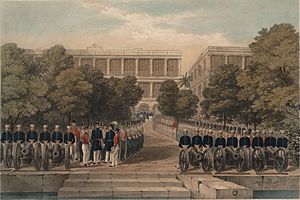Expedition to Canton facts for kids
Quick facts for kids Expedition to Canton |
|||||||
|---|---|---|---|---|---|---|---|
 British troops awaiting the arrival of Commissioner Keying at the British Factory in Canton |
|||||||
|
|||||||
| Belligerents | |||||||
| Commanders and leaders | |||||||
| John Davis George D'Aguilar |
Keying | ||||||
| Strength | |||||||
| 966 troops 6 ships |
Unknown | ||||||
| Casualties and losses | |||||||
| No casualties | No casualties 879 guns captured |
||||||
The Expedition to Canton was a short military trip by the British in China. It happened on April 2–3, 1847. During this trip, British forces captured forts along the Pearl River in the Guangdong province. The city of Canton (now Guangzhou) was the main target.
This action was a response to British people being attacked near Canton. The British Governor of Hong Kong, John Davis, demanded that the Chinese official, Commissioner Keying, fix the problem.
Governor Davis was not happy with Keying's answer. So, he ordered Major-General George D'Aguilar to act. D'Aguilar was the leader of British forces in China. His job was to take control of the forts near Canton. He also had to get ready to attack the city itself. This was to force the Chinese to pay for the damage. The British captured the forts. But Canton was not attacked after Keying agreed to punish those who caused the trouble. He also agreed to let the British enter the city.
Contents
What Happened During the Expedition?
British Forces Set Sail
On the afternoon of April 1, 1847, General D'Aguilar got his orders. He was told by Governor Davis to go to Canton with his forces. By midnight, the British troops were on their ships.
The ships and troops involved were:
- HMS Vulture carried 427 soldiers from the 18th Royal Irish Regiment.
- HMS Espiegle had 149 soldiers from the 42nd Regiment Madras Native Infantry.
- The East India Company steamer Pluto carried 280 soldiers from the 42nd Regiment.
- A rented steamship called Corsair had 110 soldiers from the 18th Regiment.
- A rented small sailing ship, lorcha No. 1, was used as a gunboat. It carried soldiers from the Royal Artillery with their supplies.
- Another rented lorcha, No. 2, carried soldiers from the Royal Sappers and Miners. They had tools, ladders, and other important items.
Capturing the Bogue Forts
The British operation started by taking over the Bogue forts. These forts were at the Humen Strait. This strait is like a narrow entrance to the Pearl River. The British captured many cannons from these forts:
- Anunghoy Island: 208 cannons were taken.
- North Wangtong Island: 150 cannons were taken.
- South Wangtong Island: 109 cannons were taken.
Moving Up the Canton River
Further up the Canton River, past Whampoa Island, the British faced a barrier made of stakes. They also captured more places:
- Pachow Fort: 64 cannons were taken.
- Wookongtap Fort: 41 cannons were taken.
- Napier's Island: 49 cannons were taken.
- Whampoa Creek: 65 cannons were taken.
Forts Near Canton City
In the final part of the mission, the British captured forts just outside the city of Canton:
- French Folly: 38 cannons were taken.
- Dutch Folly: 23 cannons were taken.
- Rogue Fort: 26 cannons were taken.
- Zigzag Battery: 20 cannons were taken.
- Segment Battery: 30 cannons were taken.
- Shameen Battery: 56 cannons were taken.
Images for kids







